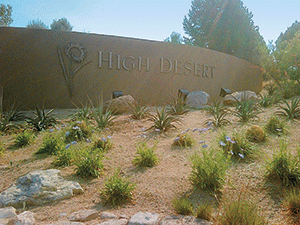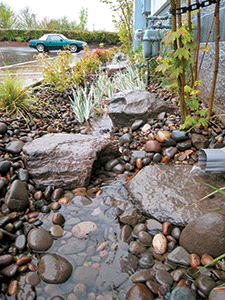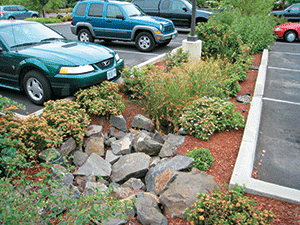
Green Industry companies explore and explain the value in providing sustainable services.
It takes a village of stewards to raise a healthy landscape. Just ask the members of Next Level Network, an executive peer group of progressive, sustainable landscape contractors from around the country who have aligned their companies’ strategy and spirit with environmental responsibility.
“It’s more than just good business; it’s a necessity,” says Andrew Key, president of Heads Up Landscape in Albuquerque, NM and a LEED-certified building professional.
While New Mexico is the Land of Enchantment, it’s also an arid one — its largest city, Albuquerque, averages only 9 inches of rain per year. Contrast that with the liquid sunshine of Oregon, where it may rain 9 inches in a week, and you might wonder how sustainable best practices work to environmental and competitive advantages in such diverse geographic regions and markets.
We thought we’d find out. We asked the Next Level leaders to share examples of how sustainability as both policy and process changed their business, transformed the customer’s landscape, and had a positive impact on the communities they serve.
High desert
Drought-tolerant landscapes are a natural for Heads Up, the Albuquerque firm located in the expansive Chichuahuan Desert and founded by CEO Gary Mallory in 1974.
“Our region hosts a fragile ecosystem richly endowed with a variety of plant life,” says Key. “The extremes of hot and cold, the varied terrain with altitudes ranging from 2,000 to 10,000 feet, and the fact that it’s the most thickly vegetated desert in North America, presents more than its share of opportunities for landscapers to work in harmony with the whims of nature.”

Both fans of native desert plants, Key and Mallory are experts in the landscape palette of northern New Mexico. They have worked with their customers to restore many properties to a sustainable desert aesthetic, installing regionally indigenous plants and high-tech water conservation and irrigation systems.
Heads Up’s xeriscape conversion program, and its commitment to creating and maintaining sustainable sites (“long before it was a formal initiative,” notes Key), puts Heads Up in the ranks of companies well positioned to become effective partners with architects and developers of commercial properties seeking to achieve energy-efficiency status through LEED. In fact, resource conservation is the prevailing cultural spirit in New Mexico, according to Key. The Albuquerque-
Bernalillo County Water Authority recently announced it met its water mandates three years before the state deadline, and saved billions of gallons of water in the process.
“Getting the public on board with environmentally responsible commitments is exciting,” adds Key. “It gives us the opportunity to be the go-to resource throughout northern New Mexico for environmentally responsible and energy-efficient landscapes and public spaces. When we collaborate with our customers, it makes us all partners for a green alliance.”
Organic eco-nomics
Landscape architect Paul Fields is both Lambert Landscape Co.’s president and sustainability driver. He maintains that deep drought patterns, tough water restrictions and aquifer constraints give his Dallas-based company an opportunity to lead the resource management discussion with its customers on water use and earth-friendly practices.
Founded in 1919, Lambert committed to becoming environmentally conscious in 1986 — and by 1989, it was 100% organic. Today, the firm captures rainwater in an on-site harvesting and storage system. The water is collected from the roof of Lambert Landscape Co.’s 6.5-acre facility. From this, the company brews its own “compost tea” — a high-quality, proprietary nutritional product used to enrich and condition clients’ soil.
“It’s all about the soil,” says Fields, noting the company’s motto (and business model): “A healthy soil leads to healthy plants and a healthier ecosystem.”

Portland, OR office,
the company’s sustainability efforts include annual sustainability fairs and rainwater gardens.
In 2011, the company earned a Sustainable Company award from the Professional Landcare Network (PLANET). Fields says that his company is continually improving upon its organic gardening knowledge and uses headquarters and project sites to research and test new products, applications and ways to optimize and improve garden sustainability.
Texas is known for being one of the driest and hottest regions during the summer, but it’s quickly becoming a hub in America’s growing rainwater harvesting industry. Lambert has seen a rise in the demand for cisterns, well water and catchment systems and is active in educating clients about their sustainable benefits.
Liquid sunshine
Bob Grover, CEO of Pacific Landscape Management, has turned perennially damp weather into a teachable moment for his community of Portland, OR. His company hosts annual sustainability fairs to showcase rainwater harvesting technologies, vertical landscapes (green walls), and rainwater gardens at its green-centric corporate facility — a sustainable site where architecture and landscape come together as public space.
“It’s a learning lab,” he explains, adding that it illustrates the best of what the future holds for energy-efficient environments, inside and out, and an example of how Pacific has re-engineered itself to minimize its impact on the environment.
Named by Oregon Business Magazine as one of Portland’s Best Green Companies, Grover said Pacific has only just begun.
“Sustainability is not a destination,” he says. “It’s a process.”
Whether it’s achieving high standards for recycling or for contributing to reductions in storm water runoff, Pacific Landscape Management is generating more than its own electricity; it’s generating ideas and solutions for the region’s ecological future.
Progressively green
A week without rain in Oregon may be a drought; an entire winter without rain is normal for most of California, which long has been a leader in passing progressive environmental regulations.
Stay Green Inc. covers the arid San Fernando Valley northwest of Los Angeles. CEO Chris Angelo knows firsthand the impact that environmental issues can have on water-dependent southern California — and in response, he’s made sustainability synonymous with his brand.
In 2011, Stay Green announced a program geared toward reducing its customers’ carbon footprints and raising the bar for environmental leadership.

“In landscape management, sustainable practices are best practices,” says Angelo. “Our company has always strived to provide responsible environmental stewardship, and our new emphasis on sustainability practices brings this approach to the forefront of all of our service lines — maintenance, water management, tree care and plant health care. We’re saving money and helping the planet at the same time.”
Stay Green also is addressing regional air quality with reduced-emission vehicles. It’s also recycling customers’ green waste, introducing custom soil blends, using organic fertilizers and pest control products and installing high-tech irrigation and water management systems.
“We’re doing so willingly to set a higher standard for ourselves and our work,” Angelo says. “We expect to see an increase in environmental regulations and incentives from the government in the coming decade, and a lot more companies will be investing in greener strategies. When our customers are ready to do that, we’re ready to help them succeed.”
Great Lakes Watershed
Mariani Landscape in Lake Bluff, IL, finds its customers easily engaged in the water-smart conversation; metropolitan Chicago abuts to an ecologically rich region that supports a wealth of biological diversity.
“Our customers are committed to environmental responsibility on principle; it’s the right thing to do,” says landscape architect and LEED-savvy garden designer John Mariani. “We don’t see as much dryness as other parts of the country, but our customers in general are passionate about the natural beauty of Lake Michigan’s unique watershed and respectful of its natural resources. This makes conversations about water use technologies, alternatives to overused plants in the landscape, and sustainable best practices easy to have.”
John’s brother, company CEO Frank Mariani, agrees. He was awarded “Mentor to the (Green) Industry” in 2011 and says the firm founded by their father 50 years ago aims to prosper by adding value.
“We use eco-friendly practices to enhance our customers’ properties, and that reflects our long-term commitment to being a steward of the land,” he says.
The firm also is known for its community stewardship. Many of Mariani Landscape’s herbaceous experts, horticulturists and LEED-certified designers teach garden workshops. Some associates even volunteer to assist public land trusts and recreation areas by creating walking paths and enhancing nature preserves.
Heritage meets high-tech
According to the U.S. Drought Monitor, Alaska and Ohio are the only states entirely drought-free. So, no landscape problems in Ohio, right?
Not necessarily, says Todd Pugh, CEO of Enviroscapes, a 25-year-old firm in Louisville, OH. Pugh says it’s easy to assume that because a landscape looks “green,” it’s sustainable. It’s not.
Sustainable means that an attractive landscape in any region — park, private home, HOA, utility corridors, corporate campuses or recreation areas — can be as useful as it is beautiful if it is planned and planted in a way that ultimately contributes to storm water control; protects limited resources such as water; reduces pollution; and protects wildlife.
Located in northeast Ohio, Enviroscapes embraced green early on. The company recently rebranded to reflect its sustainable initiatives. Since 1994, Pugh says, the firm has reused green waste, reduced the number of raw materials used on projects, and recycled more than 40,000 cubic yards of debris. It’s the same as conserving landfill space the size of a 10-story-high football field.
Pugh’s vision for sustainability is one of practicality. Whether recycling or replacing fleet vehicles with hybrid and high-mileage alternatives to improve fuel consumption, being green needs to make sense.
“At Enviroscapes, sustainability is a value proposition,” he explains. “We find that most of our earth-friendly practices not only are profitable but also benefit our employees. This aligns with our corporate philosophy of ‘People, Planet and Profit.’”
Pugh says all three can work in harmony when properly thought out. He’s educating his customers about what they can do to protect the environment.
“We want to be experts and let them know that doing simple things can make a big impact,” he says.
Where do we go from here?
If there is a crystal ball that holds the future success of the landscaping industry, it’s in the hands of Jim McCutcheon, certified landscape professional and CEO of HighGrove Partners, an interdisciplinary land services company in Atlanta.
He’s also a landscape architect and chairperson of PLANET’s Crystal Ball Committee.
“HighGrove decided a long time ago to integrate progressive water technologies and innovative resource programs into its daily suite of offerings,” McCutcheon says. “At the time, we were ahead of trend.”
The proactive approach paid off. Georgia has weathered several serious drought cycles, and HighGrove’s KnowWater program has achieved measurable results. The program is saving between 20% and 40% water use and maximizing the efficiency of systems for customers who support the program.
According to McCutcheon, environmental responsibility and economic responsibility aren’t mutually exclusive.
“We all agree it’s the right thing to do,” he says. “But why wouldn’t you want to? Especially when you can save water, reduce demand and produce financial savings as a return on investment?”
HighGrove makes a strong case for the partnership role landscape firms play in decreasing costs. Building owners and property managers are measuring and reporting energy costs and use by real-time monitoring of building infrastructure systems. Many city managers and urban developers also are looking for savings.
“Water management is where this becomes a formal stewardship effort,” he concludes. “If the goal is a measurable reduction of water use over a specified period of time, then we have an ability to make an impact in a significant way. Not only are our efforts as landscape professionals good for the environment, they are just good business.“
Next Level Network is a Green Industry peer group facilitated by Bruce K. Wilson, Wilson-Oyler Group. For information on peer group networking, contact Wilson at 805/390-2357 or bwilson@wilson-oyler.com.

